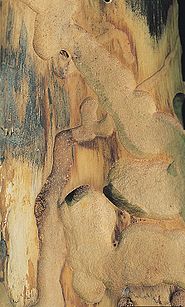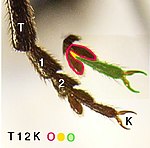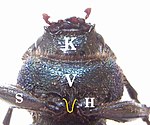Blue-violet disc buck
| Blue-violet disc buck | ||||||||||||
|---|---|---|---|---|---|---|---|---|---|---|---|---|

Blue-violet disc buck ( Callidium violaceum ) |
||||||||||||
| Systematics | ||||||||||||
|
||||||||||||
| Scientific name | ||||||||||||
| Callidium violaceum | ||||||||||||
| Linnaeus , 1758 |
The blue-violet disc Bock ( Callidium violaceum ), and Violet Bock called, is a beetle from the family of longhorn beetles . The German name harbors the risk of confusion with the “blue-colored disc goat” , also known as the “blue disc goat” ( Callidium aeneum ).
Comments on the name and the system
The species was first described by Linnaeus in 1758 and classified as No. 43 in the genus Cerambyx . The description reads: Cerambyx thorace mutico subrotundo, corpore violaceo, antennis mediocribus ( Latin longhorn beetle, breast unarmed and round, body violet, antennae medium-long). Since the characterization of the breast applies to all disc bucks, the species was given the Latin name Cerambyx violaceus (violet longhorn beetle) by Linnaeus .
The genus Callidium (from ancient Greek κάλλος kállos, beauty and ίδιος ídios, own) was established in 1775 by Fabricius based on the construction of the mouthparts as the 50th genus. In German, the generic name is usually rendered with a disk buck. The genus comprises three species in Europe and over thirty species worldwide, some of which are grouped into subgenera.
Characteristics of the beetle
The beetle, which is metallic purple or blue to blue-green due to the color of the head, pronotum and wing covers, is 8 to 16 millimeters long. It has short rust-brown hairs. The body and legs are brown to blackish brown.
The legs are strong, the thighs petiolate at the base, then thickened like a club. As with all longhorn beetles, the rails have two end spurs. The tarsi are apparently four-limbed ( pseudotetrameric ) because the very small fourth limb is difficult to see in the section of the third, lobed limb and acts like the base of the claw limb (Fig. 1). The claws on the last tarsal link are without teeth at the base. The hips of the forelegs, which connect the foremost pair of legs with the front chest, protrude from the chest in a cone. They are close to each other but do not touch. The cavities in the front chest, in which they are turned, are not closed to the rear. The extension of the fore chest, which delimits the joint cavities from one another, is so short that it does not even reach the center of the front hips (Fig. 2).
The head is wider than it is long, and most of the mouthparts are visible from above. The eyes are heavily rimmed and have the shape of a kidney. They partially encompass the sensor base, their inner edges are closer to each other than the inner edges of the feelers . The individual facets of the eyes can be seen at ten times magnification. The head does not taper significantly behind the eyes. The eleven-limbed antennae are rather short for longhorn beetles, a little longer for males, but they do not reach the end of the body by far. The second antenna segment is significantly shorter than the third, the fifth is significantly smaller than the third and fourth combined.
The pronotum is wider than it is long (across). Its upper flat part, which is called a disk, has a large area, which has given the genus the name of disk buck. The pronotum is clearly visible, roughly dotted with three smooth spots. It is outlined on the front edge and has a narrow border on the back. The sides are clearly rounded.
The blue wing-coverts are also roughly and evenly wrinkled. They are flat and completely cover the abdomen. Their sides run parallel to the body axis and are rounded at the back so that together they form a semicircle. At the base they have epipleurs , which distinguishes C. violaceum from C. aeneum . The label is round and easily recognizable.
Way of life and biotope

|

|
| Image 3: On hold | |

|
|
| Photo 4: pairing | Photo 5: Feeding tunnels |
The adults hatch in May to July. They often remain in the places where they developed, so that numerous generations can develop in the same place over the years. Cases are known from Sweden where the beetle has stayed in built-up wood for up to 70 years.
The males move into a control room with a good overview (Fig. 3). Competing males are driven away, females are persecuted. After mating (Fig. 4), the mated females lay the eggs in cracks in the bark with the laying tube. Debarked wood is not attacked and the wood must still be sufficiently moist for the attack. The larvae have stunted legs that are still visible. Except for the dark mouthparts, they are ivory to white. They are up to 17 millimeters long and crawl around. The larvae eat widening passages directly under the bark (Fig. 5). With all Callidium species, these are loosely stuffed with drilling dust. Dark balls of manure are mixed into the very fine, light nailed nail, which is why the drilling dust is called marbled or has a salt and pepper character . The drilling dust contains only a few large chips. The drill holes are very shallow and wide, initially about 1.5 centimeters, later up to twice as wide (damage caused by space). They are sharp-edged, meandering, often cross and run right under the bark. Towards the end of the development, a hook-shaped passage is drilled vertically into the wood and the doll's cradle is placed. The wood can be damaged to a depth of ten centimeters. In addition, the development can also be successfully completed here in debarked and built-in wood. The hatched beetles work their way back under the bark through the hook passage and gnaw exit holes through the bark at the end. The exit holes are flattened oval, six to eight millimeters wide and half as high.
The development usually takes two years in Central Europe, but can be completed in a year in a warmer environment.
Usually only coniferous wood is attacked, but occasionally also hardwood. Even small remains of bark are sufficient for successful development, e.g. B. on rinds that are used as packaging material. In firewood stalls or in the roof stalls of sheds or hay barns where wood that has not been debarked has been used, the disc buck finds favorable conditions and can also occur frequently. In particular, when the beetles hatch, a mass occurrence lasting only a few hours can occur.
distribution
The species originally came from Palearctic in Northern and Central Europe , Southeastern Europe, Asia Minor , Syria and in Siberia via Northern Mongolia and Manchuria to Korea and Japan . It was introduced to the North American continent and is now classified as Holarctic . Finds are known from Newfoundland , Eastern Canada and Northeast America. However, the species was also introduced into Uganda . In Australia , the risk of being introduced and settled is classified as high; the beetle has already been found in the packaging of imported goods. Appropriate treatment ensures that the beetle is not brought in with packaging material made of wood. In New Zealand , too , care is taken to ensure that the beetle does not enter the country with packaging material. It can be assumed that it is already more widespread undetected.
In Central Europe it is found in coniferous forests on the plains and in the mountains up to the tree line in subalpine locations. It is more common in the east than in the west. In some areas, however, it is rare or unknown.
Harm and protection
The species is classified as endangered in the Red List of Saxony-Anhalt , in Schleswig-Holstein and Brandenburg it is on the warning list as potentially endangered, in Mecklenburg-Western Pomerania the species is classified as not endangered. The grazing under the bark does not damage the wood significantly, but the dolls' cradles can lie up to 10 cm in the wood. Overall, however, the damage caused by Callidium violaceum is classified as minor. As a countermeasure, it is sufficient to completely debark the felled wood. In Australia, too, the potential damage caused by the introduction is classified as low. On the other hand, the species is also ecologically important for other animal species. So serve z. B. the empty pupae cradles solitary Hymenoptera as a breeding ground.
literature
- Heinz joy, Karl Wilhelm Harde, Gustav Adolf Lohse (ed.): The beetles of Central Europe . tape 9 . Cerambycidae Chrysomelidae . Spektrum Akademischer Verlag, Munich 1999, ISBN 3-8274-0683-8 (first edition: Goecke & Evers, Krefeld 1966).
- Klaus Koch : The Beetles of Central Europe . Ed .: Heinz Freude . tape 3 : ecology . Goecke & Evers, Krefeld 1992, ISBN 3-87263-042-3 .
- Adolf Horion : Beetle science for nature lovers . Vittorio Klostermann, Frankfurt am Main 1949
Web links
Individual evidence
- ↑ Callidium violaceum in Fauna Europaea. Retrieved February 20, 2013
- ↑ C.Linnaeus: Systema Naturae per Regna tria naturae, secundum classes, ordines, genera, species, cum characteribus, differentiis, synonymis, locis. Tomus I. Editio decima, reformata Stockholm 1758 first description page 399: 395, no.43
- ↑ Sigmund Schenkling: Explanation of the scientific beetle names (genus)
- ↑ Io. Christ. Fabricius: Systema Entomologiae Flensburg, Leipzig 1775 First description of the genus p. 223: 187 50.
- ↑ Callidium in Fauna Europaea. Retrieved February 19, 2013
- ↑ Callidium at BioLib
- ↑ Heinz Freude, Karl Wilhelm Harde, Gustav Adolf Lohse (ed.): Die Käfer Mitteleuropas . tape 9 . Cerambycidae Chrysomelidae . Spektrum Akademischer Verlag, Munich 1999, ISBN 3-8274-0683-8 (first edition: Goecke & Evers, Krefeld 1966).
- ^ Carl Gustav Calwer and Gustav Jäger (editors): CG Calwer's Käferbuch . K. Thienemanns, Stuttgart 1876, 3rd edition
- ↑ a b c Regulations for the treatment of packaging material when imported into Australia ( Memento of the original from July 22, 2014 in the Internet Archive ) Info: The archive link has been inserted automatically and has not yet been checked. Please check the original and archive link according to the instructions and then remove this notice.
- ↑ Information on wood attack by Callidium
- ↑ Information cards on forest pests ( Memento from May 2, 2012 in the Internet Archive )
- ↑ a b Building information on Callidium ( Memento of the original from September 27, 2007 in the Internet Archive ) Info: The archive link was automatically inserted and not yet checked. Please check the original and archive link according to the instructions and then remove this notice.
- ↑ Federal information on forest management
- ↑ a b Adolf Horion: Faunistics of the Central European Beetles, Vol. XII . Überlingen-Bodensee 1974
- ^ Technical training on structural damage ( Memento from May 10, 2005 in the Internet Archive )
- ^ A b Polish Forest Information
- ↑ Protective measures for imports into New Zealand ( Memento from September 28, 2007 in the Internet Archive )
- ↑ Red lists at Science4you
- ↑ Red List of Saxony-Anhalt
- ↑ Use of the doll's cradle by solitary Hymenoptere Aculeata ( Memento from September 28, 2007 in the Internet Archive ) (PDF; 4.2 MB)

